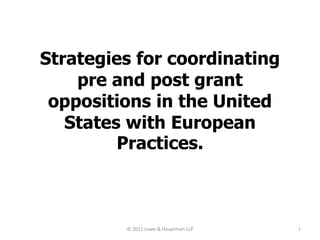Mais conteúdo relacionado Semelhante a Pre and Post Grant Strategies in US and Europe (20) 1. Strategies for coordinating
pre and post grant
oppositions in the United
States with European
Practices.
© 2011 Lowe & Hauptman LLP 1
2. Kinds of Oppositions
• Pre Grant
– Before Grant
– After Publication (18 months)
– Third Party Observations
• Post Grant
– After the Grant
– Within a stipulated time
– Revocation Proceedings
© 2011 Lowe & Hauptman LLP 2
3. Pre-Grant in US
• No Pre-Grant in US (Before AIA)
• Reasons –
– Undue burden on the applicant
– Additional Cost to the Patent Office (Hearings)
– Delays the examination process
– Major Pharmaceutical Companies Opposed
(Patent Term Restoration – Not more than 5 years)
© 2011 Lowe & Hauptman LLP 3
4. After AIA
• AIA (America Invents Act) -
– Introduced Pre-Grant oppositions by way of ‘Third
Party Submissions’
– Effective Date – 16th Sep 2012.
– Governing rules from the USPTO (Expected Aug
2012)
© 2011 Lowe & Hauptman LLP 4
5. After AIA
• When a Third Party can File?
– Before –
• the date of allowance (§ 151)
– Later of –
• 6months after the first publication (§ 122)
• After the first rejection date (§ 132)
© 2011 Lowe & Hauptman LLP 5
6. Third Party Submissions
• What can be submitted?
– Any Granted Patent
– Any Published Patent Application
– Any Prior Art Document
• Potentially Relevant
• Publicly available
• Before the Application Date
– Lack of Inventive Step
• Prior Discoveries (Lab Records)
© 2011 Lowe & Hauptman LLP 6
7. Other Requirements
• Third Party Submissions should be
accompanied by -
– A brief and concise description on “How the
document is potentially relevant?”
– Affidavit by the Third Party
– Prescribed Fees
© 2011 Lowe & Hauptman LLP 7
8. Post-Grant in US
• Before AIA –
– Only Inter Partes
• Any time after the date of Grant
• Till the end patent term
• No “Reasonable Likelihood of winning” is required
– Reasonable = 75% ??
© 2011 Lowe & Hauptman LLP 8
9. Post-Grant in US
• After AIA –
– Effective Date – 16th March 2013
– New Post Grant Review Mechanism (Like Europe)
• Time Limit –
– Within 9 months from the date of Grant
• Broad Scope – Unlike Europe
– Any ground of invalidity.
© 2011 Lowe & Hauptman LLP 9
10. Post-Grant in US
• Steps in Post Grant Review –
– Filing an opposition
– Opposition requires a showing that it is “more
likely than not” (51%) that at least one claim is
unpatentable
– Preliminary response by the patent owner
– (within 3 months) The USPTO has to decide
whether or not to allow that opposition “more
likely than not”
– Hearings / Trail
© 2011 Lowe & Hauptman LLP 10
11. Inter Partes
• Who?
– Any person other than the owner of the patent
• When?
– Starts any time after the expiry of 9 months from
the date of Grant ( or After the termination of
Post-Grant Review Proceedings)
– 9 months after the re-issue of patent
– Extends till the end of Patent Term
© 2011 Lowe & Hauptman LLP 11
12. Inter Partes
• Limited Grounds
• Only Grounds –
– 102 & 103
– Printed Publication and Granted Patents
– Not beneficial if Continuation Application is filed
• Reasonable Likelihood that opposing party
will prevail.
© 2011 Lowe & Hauptman LLP 12
13. Pre Grant in Europe
• Third Party Observations
• After Publication
• Before the Allowance
• Examiner may consider even after the
allowance (In this situation re-examination will
be done)
• No official fees
© 2011 Lowe & Hauptman LLP 13
14. Pre Grant in Europe
• The opposing party will not become a party to
the proceedings
– Third Party can not argue before the examiner
– Discretion of the Examiner
• If examiner is not convinced during the third
party observation – No hope for the Post-
Grant Opposition (Post Grant is better)
© 2011 Lowe & Hauptman LLP 14
15. Pre Grant in Europe
• Grounds –
– Only Patentability
• Novelty
• Utility
• Non-Obviousness
• This Third Party Observations may encourage
the applicant to file “Divisional Applications”
– Which he could not do after the grant.
© 2011 Lowe & Hauptman LLP 15
16. Post Grant in Europe
• When?
– After the Grant
– Within 9 months
• Who?
– Any person
– Except the owner of the patent
© 2011 Lowe & Hauptman LLP 16
17. Post Grant in Europe
• Grounds –
– Not patentable
• Novelty
• Inventive Step
• Excluded Subject Matter
– Not enabling (Disclosure Enablement)
© 2011 Lowe & Hauptman LLP 17
18. Post Grant in Europe
• Procedure –
– Notice of Opposition
• Evidence (Prior Art Documents)
• Facts
• Arguments to be relied on
• Documents submitted at a later date with out no good
reason will be ignored.
– Response by the owner
• Amendment
© 2011 Lowe & Hauptman LLP 18
19. Post Grant in Europe
– Preliminary opinion by the Opposition Division
– Oral proceedings
– Decision by the opposition Division
– Appeal
• Note : Unlike Pre Grant - Post Grant
Oppositions has to be filed in the respective
National Courts.
© 2011 Lowe & Hauptman LLP 19
20. Strategies
• For Example one filed an Application in US and
Europe –
• Which one to be opposed First?
• Why?
© 2011 Lowe & Hauptman LLP 20
21. Strategies
US Europe
• File Pre Grant (Third • Post Grant
Party Submissions) • Based on the US
• It invokes Discovery Discovery
for Info. • Pre Grant in Europe is
weak as it doesn’t
allow the opposing
party to argue before
the examiner
© 2011 Lowe & Hauptman LLP 21
